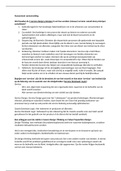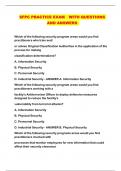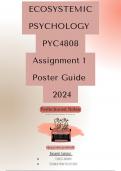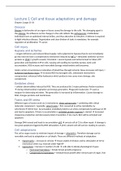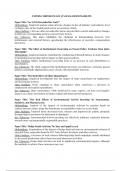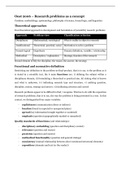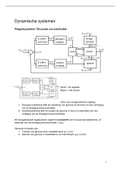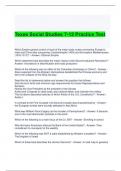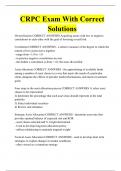Chapter 1
1.1 Introduction
Advertising seek to influence us, in the hope of encouraging a specific type of behavior. We might
not recall many messages; we do recognize them.
1.2 a brief history of influence search
Plato language to persuade others. Power to persuade is determined by characteristics of the
source of the information, its recipient and its content. Important to consider the public you are
addressing.
1.2.1 attitudes
First research was emphasized on linguistics of a message, later shifted more towards the process
involved in persuasion
Harold Laswell created first model of communication, ‘who says what in which channel to whom,
with what effect?’
characteristics of the person issuing the message (who), the content of the information
being communicated (what), the medium used to transmit it (which channel), the
characteristics of the intended recipient (to whom) and the extent to which their opinions or
preferences are influenced as a result (what effect).
An attitude describes an evaluative response – positive or negative – to a person, a situation, a
product, an idea or an organisation.
Factors like the reliability and expertise of the source help to determine how a message
affects the recipient’s attitudes and behavior. Hovland and his colleagues soon realised that the
direct impact of a message often differs from its indirect or delayed effect
Hovland’s team devised a four-step process model of persuasion: yale model of persuasion.
1. People must pay attention to the information contained in a message.
2. The message must be presented in such a way that it is understood.
3. The recipient can accept it and modify their attitude accordingly.
4. The recipient must also retain their new attitude
inoculation theory McGuire sets out how people can arm themselves against information intended
to influence and change their opinion.
The process of persuasion in a similar way as the originators of the Yale model. He identifies
six steps: presentation, attention, comprehension, yielding (accepting the arguments put
forward), retention and, finally, behaviour. The steps were more dynamically related and
could influence each other.
Anthony Greenwald further developed McGuire’s ideas in his cognitive response theory.
His work examines the way in which information is processed, and how that affects
attitudes. Such information is often coupled and compared with existing attitudes and
preferences, and possibly even integrated into them. It is these interim processes which
determine whether, in the end, a person’s attitude and behaviour will be modified.
1.2.2 advertising and influence
AIDA model, proposed by Edward Kellogg Strong ‘Attention, Interest, Desire, Action’. Later the
addition of an ‘S’ for ‘satisfaction’ (AIDAS) as a necessary component to assure customer loyalty and
so generate repeat purchases. Only if the client is happy with the product will the process
culminating in a transaction be repeated.
,Chapter 2
2.1 Introduction
Try to influence attitudes which can lead to behavioral change
Attitudes refer to people evaluation responses to a stimulus, the so-called attitude object
Attitude object can be a person, organization, situation, product, idea
Origins of research start in 1920s.
First was based on attitude measurements, Thurstone’s famous article of 1928 “attitudes
can be measured.
There was also interest in how attitudes affect behavior, LaPiere (1934) conducted an
experiment with Chinese woman at Chinese restaurant.
2.2 Attitudes, attitude formation and behavior
Attitude is not directly measurable, it is a latent concept, has to be inferred form the visible reposes
induced by the attitude object.
Three components of attitude
1. Cognitive response (beliefs and opinions)
a. Compromised the thoughts aroused by particular characteristics of the attitude
object, on the basis of which we form an evaluative judgment about it
2. Affective response (feelings and emotions)
a. The form of feelings, sentiments or emotions an attitude object elicits
3. Behavioral response (actions and conduct)
a. Consumer buying habits, voter behavior in elections and interpersonal activities,
such as helping someone you like
Behavior is the consequence of an attitude toward which both cognitive considerations and affective
reactions have contributed, can also influence the cognitive and affective responses to an attitude
object (some components weigh more than others).
Attitudes are an evaluative reaction based on cognitive and affective responses evoked by
an attitude object, which then determines behavior
5 characteristics of attitude
1. Focus on an object, person, organization or event.
2. Evaluative, either positively or negatively.
3. Can be based on cognitive beliefs about characteristics of the attitude object.
4. Can be based on affective responses to the attitude object.
5. Repercussions for behavior towards the attitude object.
2.3 Reasoned and intuitive attitudes
Dual-process models tried to differentiate between careful information processing and perfunctory
superficial information processing
Elaboration likelihood model by Petty and Cacioppo
Central route to persuasion
o High degree of thought. Attitudes are formed or modified after thorough
consideration and analysis of the core characteristics of the attitude object
Peripheral route to persuasion
o Relatively low degree of thought. Attitudes are formed by drawing on characteristics
of the attitude object or the situation, such as the source of the information, which
are only indirectly relevant of the issue at hand
, Self-relevance can change how much you think about a topic, if it’s important you will think first
about the quality of the arguments. If it’s not important you rather think about the quantity of
arguments.
People who are highly involved are more likely to follow the central route, and actively process the
arguments. People who are low involved are more likely to follow the peripheral route, and pay less
attention to the arguments.
Heuristic systematic model by Shelly Chaiken
Distinction between systematic thorough information processing and more superficial,
heuristic information processing.
Whereas in the elaboration likelihood model the two routes (central and peripheral) are seen as
mutually exclusive, in the heuristic systematic model both routes can be taken simultaneously.
2 systems model by Daniel Kahneman
Distinction between 2 systems
1. Intuitive and quick
a. Fast, automatic, parallel, little effort, associative, affectively charged
2. Analytical and relatively slow
a. Slow, controlled, serial, much effort, reasoned, neutral
Strong attitudes are often based upon reasoned, cognitive consideration and are held in respect of
subjects that matter to the person concerned
2.4.1 Likert method of summated rating
Requires a list of items expressing a positive or negative opinion about the attitude object that we
want to research. 5-point scale ranging from strongly disagree to strongly agree. Usually between 8-
15 statements presented in a random order
2.4.2 sematic differential
Osgood, Suci and Tannenbaum
Bipolar scales: clever and stupid, good and bad, honest and dishonest.
How much they believe these words apply to the attitude object (5- or 7-point scale) ranging from -3
to +3
Advantages and disadvantages
+ Reasonably reliable, tallying well with those obtained using alternative methods
+ Same amassment dimension assessment different attitudes – attitudinal comparison can also be
a disadvantage
- In the context of one attitude object, the same scale can have a very different meaning than
when applied to another
2.4.3 measuring reasoned attitudes and behavioral preferences
Theory of reasoned action by Fishbein and Ajzen led to the theory of planned behavior that
attitude towards a behavior is based on an expectancy-value analysis of the consequences
(behavioral beliefs) of this behavior.
Expectancy of a consequence probability that a certain consequence will result if you perform a
certain behavior.
People can have different reactions due to their own knowledge and experience, and the association
of such experience is called belief. The behavioral intention is also influenced by social norms.
1.1 Introduction
Advertising seek to influence us, in the hope of encouraging a specific type of behavior. We might
not recall many messages; we do recognize them.
1.2 a brief history of influence search
Plato language to persuade others. Power to persuade is determined by characteristics of the
source of the information, its recipient and its content. Important to consider the public you are
addressing.
1.2.1 attitudes
First research was emphasized on linguistics of a message, later shifted more towards the process
involved in persuasion
Harold Laswell created first model of communication, ‘who says what in which channel to whom,
with what effect?’
characteristics of the person issuing the message (who), the content of the information
being communicated (what), the medium used to transmit it (which channel), the
characteristics of the intended recipient (to whom) and the extent to which their opinions or
preferences are influenced as a result (what effect).
An attitude describes an evaluative response – positive or negative – to a person, a situation, a
product, an idea or an organisation.
Factors like the reliability and expertise of the source help to determine how a message
affects the recipient’s attitudes and behavior. Hovland and his colleagues soon realised that the
direct impact of a message often differs from its indirect or delayed effect
Hovland’s team devised a four-step process model of persuasion: yale model of persuasion.
1. People must pay attention to the information contained in a message.
2. The message must be presented in such a way that it is understood.
3. The recipient can accept it and modify their attitude accordingly.
4. The recipient must also retain their new attitude
inoculation theory McGuire sets out how people can arm themselves against information intended
to influence and change their opinion.
The process of persuasion in a similar way as the originators of the Yale model. He identifies
six steps: presentation, attention, comprehension, yielding (accepting the arguments put
forward), retention and, finally, behaviour. The steps were more dynamically related and
could influence each other.
Anthony Greenwald further developed McGuire’s ideas in his cognitive response theory.
His work examines the way in which information is processed, and how that affects
attitudes. Such information is often coupled and compared with existing attitudes and
preferences, and possibly even integrated into them. It is these interim processes which
determine whether, in the end, a person’s attitude and behaviour will be modified.
1.2.2 advertising and influence
AIDA model, proposed by Edward Kellogg Strong ‘Attention, Interest, Desire, Action’. Later the
addition of an ‘S’ for ‘satisfaction’ (AIDAS) as a necessary component to assure customer loyalty and
so generate repeat purchases. Only if the client is happy with the product will the process
culminating in a transaction be repeated.
,Chapter 2
2.1 Introduction
Try to influence attitudes which can lead to behavioral change
Attitudes refer to people evaluation responses to a stimulus, the so-called attitude object
Attitude object can be a person, organization, situation, product, idea
Origins of research start in 1920s.
First was based on attitude measurements, Thurstone’s famous article of 1928 “attitudes
can be measured.
There was also interest in how attitudes affect behavior, LaPiere (1934) conducted an
experiment with Chinese woman at Chinese restaurant.
2.2 Attitudes, attitude formation and behavior
Attitude is not directly measurable, it is a latent concept, has to be inferred form the visible reposes
induced by the attitude object.
Three components of attitude
1. Cognitive response (beliefs and opinions)
a. Compromised the thoughts aroused by particular characteristics of the attitude
object, on the basis of which we form an evaluative judgment about it
2. Affective response (feelings and emotions)
a. The form of feelings, sentiments or emotions an attitude object elicits
3. Behavioral response (actions and conduct)
a. Consumer buying habits, voter behavior in elections and interpersonal activities,
such as helping someone you like
Behavior is the consequence of an attitude toward which both cognitive considerations and affective
reactions have contributed, can also influence the cognitive and affective responses to an attitude
object (some components weigh more than others).
Attitudes are an evaluative reaction based on cognitive and affective responses evoked by
an attitude object, which then determines behavior
5 characteristics of attitude
1. Focus on an object, person, organization or event.
2. Evaluative, either positively or negatively.
3. Can be based on cognitive beliefs about characteristics of the attitude object.
4. Can be based on affective responses to the attitude object.
5. Repercussions for behavior towards the attitude object.
2.3 Reasoned and intuitive attitudes
Dual-process models tried to differentiate between careful information processing and perfunctory
superficial information processing
Elaboration likelihood model by Petty and Cacioppo
Central route to persuasion
o High degree of thought. Attitudes are formed or modified after thorough
consideration and analysis of the core characteristics of the attitude object
Peripheral route to persuasion
o Relatively low degree of thought. Attitudes are formed by drawing on characteristics
of the attitude object or the situation, such as the source of the information, which
are only indirectly relevant of the issue at hand
, Self-relevance can change how much you think about a topic, if it’s important you will think first
about the quality of the arguments. If it’s not important you rather think about the quantity of
arguments.
People who are highly involved are more likely to follow the central route, and actively process the
arguments. People who are low involved are more likely to follow the peripheral route, and pay less
attention to the arguments.
Heuristic systematic model by Shelly Chaiken
Distinction between systematic thorough information processing and more superficial,
heuristic information processing.
Whereas in the elaboration likelihood model the two routes (central and peripheral) are seen as
mutually exclusive, in the heuristic systematic model both routes can be taken simultaneously.
2 systems model by Daniel Kahneman
Distinction between 2 systems
1. Intuitive and quick
a. Fast, automatic, parallel, little effort, associative, affectively charged
2. Analytical and relatively slow
a. Slow, controlled, serial, much effort, reasoned, neutral
Strong attitudes are often based upon reasoned, cognitive consideration and are held in respect of
subjects that matter to the person concerned
2.4.1 Likert method of summated rating
Requires a list of items expressing a positive or negative opinion about the attitude object that we
want to research. 5-point scale ranging from strongly disagree to strongly agree. Usually between 8-
15 statements presented in a random order
2.4.2 sematic differential
Osgood, Suci and Tannenbaum
Bipolar scales: clever and stupid, good and bad, honest and dishonest.
How much they believe these words apply to the attitude object (5- or 7-point scale) ranging from -3
to +3
Advantages and disadvantages
+ Reasonably reliable, tallying well with those obtained using alternative methods
+ Same amassment dimension assessment different attitudes – attitudinal comparison can also be
a disadvantage
- In the context of one attitude object, the same scale can have a very different meaning than
when applied to another
2.4.3 measuring reasoned attitudes and behavioral preferences
Theory of reasoned action by Fishbein and Ajzen led to the theory of planned behavior that
attitude towards a behavior is based on an expectancy-value analysis of the consequences
(behavioral beliefs) of this behavior.
Expectancy of a consequence probability that a certain consequence will result if you perform a
certain behavior.
People can have different reactions due to their own knowledge and experience, and the association
of such experience is called belief. The behavioral intention is also influenced by social norms.

